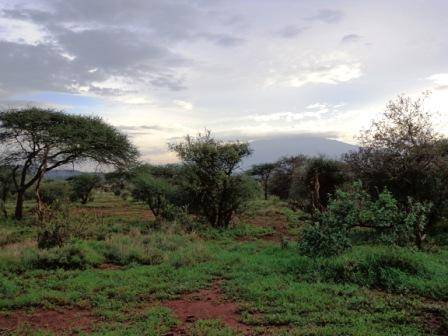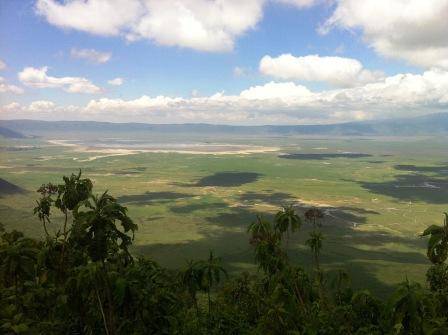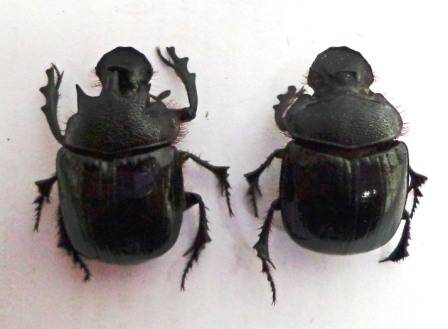Hello Beetlers!
In this blog we hear from Hitoshi Takano as he once again heads into the Tanzanian wilderness in search of those most beautiful and endearing of beetles, the scarabs!
B
"I have once more returned to the land of giraffes and honey badgers. And the rain.
I am now in the north of Tanzania and it looks just like Africa as represented in wildlife documentaries and travel agent brochures – acacia trees with animals posing for the perfect photo.
The north is a very different landscape to what I saw down in the south and is peppered with extinct volcanoes and craters including the highest peak in Africa. A great poet once said “Kilimanjaro rises like Olympus above the Serengeti”. It really does. Many of these great volcanoes have excellent forest on the slopes and this is where I am conducting my research.
A rare sight of Mt Kilimanjaro in the rainy season – usually it is covered in clouds!
With the huge populations of animals, it really is dung beetle country up here! So numerous are these beetles that they are regularly bouncing off the windscreen of our vehicle!
The first main research site was within the famous Ngorongoro Conservation Area. The Ngorongoro Highlands are a vast area of mountains and craters covered in forest and moorland.
The world famous Ngorongoro Crater. Fact of the day: Ngorongoro is so called because of the noise the cow bells make whilst the Masai people herd their cattle.
The two research sites I chose were Mt. Makarot and Empakaai crater. With the very strict regulations within the NCA, I was not allowed to camp on Makarot but instead stayed at a camp site overlooking Ngorongoro crater itself. Goodness me there are a lot of dung beetles in this area! There must have been dung beetles arriving at the light in the evening every few minutes! 5 species of Heliocopris, some very large Catharsius and some interesting looking Copris and Bolboceratids.
Aside from a few Aphodiines and a very common species of Staphylinind, that was it for the beetles which is most unusual. The nightly visitors to the light trap have been the usual culprits of bats, frogs and geckoes but on this trip we have had another hungry critter feasting on the insects – this hedgehog!
Hedgehog!
The campsite was an open grassy area and every night animals would be seen or heard at close range; lions, hyenas, elephants, jackal and the most immediate danger – buffalo. Huge herds of buffalo would wonder into the area. They seemed to stay away from the MV bulb but they would feed very near the tents. Late one evening after checking the light sheet for the final time, the herd proceeded to congregate around my tent and there was no way out. You know that feeling when you really need to go to the toilet…! They are very noisy eaters – the only thing I can liken it to is the sound of a washing machine with the occasional grunt and snort!
Three male specimens of the spectacular Heliocopris hunteri, one of the species of giant dung beetle attracted to light
From here I headed to the remote Empakaai crater which is truly magnificent. From the main crater of Ngorongoro, we drove north through the highland moorlands, which out of interest look surprisingly like the Scottish Highlands except for the occasional Masai in his red cloak and herds of Zebra, Thomson’s Gazelle and Ostrich! But apart from that the fauna is not too dissimilar – stonechats, kites and buzzards are very common up there as are clouded yellow and painted lady butterflies (Note to self: I must be much fitter to chase butterflies at just below 10000ft; the first time I did it, I thought my lungs were going to collapse!).
A panorama view of Empakaai Crater from the bottom – flamingos often congregate in large numbers on the salt lakes
Empakaai crater is in the middle of this moorland and has good forest all down the ‘bowl’ towards the salt lake at the bottom. Again due to the NCA regulations, we were not allowed to camp within the crater and had to walk in and out every day which was rather hard going (though excellent aerobic exercise)! But it was well worth it. The dung traps on the rim and inside the crater yielded very different numbers of species, with the latter producing what must be a new species of Onthophagus.
From Ngorongoro we drove to Mount Hanang via the Mbulu mountains. Hanang is the fourth highest peak in Tanzania and stands at 3,417m.
The magnificent Mt Hanang viewed from the top of the Rift Valley
The sight of this lone mountain standing tall in a barren and flat landscape when driving over the rift valley escarpment wall is awe inspiring. It also fills one with much trepidation – these mountains are incredibly unpredictable meteorologically speaking. The last time I was here, a freak storm appeared with no warning – with extreme winds up to 80mph it was rather frightening!
An exhausted HT on the summit of Mt Hanang; it is cold, wet and dark up there!
The most exciting find on the previous trip to Hanang were four male specimens of the very rare “giant” (this species really is not that big!) dung beetle Helicopris erycoides. It is so far only known from the male and my challenge for this wet season trip was to find the female. So how did I get on? Well, it is difficult to say. When one is searching for something that is unknown, how does one know if they have found it?! We literally left no dung pat unturned and from our haul of 12 Heliocopris specimens, there are two small female Heliocopris which are about the right size when compared with the male. So could this be the hitherto unknown female??!! Watch this space…
Possibly Heliocopris erycoides male (left) and if so, could this be the unknown female (right)?!
I will now be heading off to Mount Meru, the second highest peak in Tanzania (4,565m) and then the massive Mount Kitumbeine to finish this incredible seven week expedition."
HT





.jpg)
